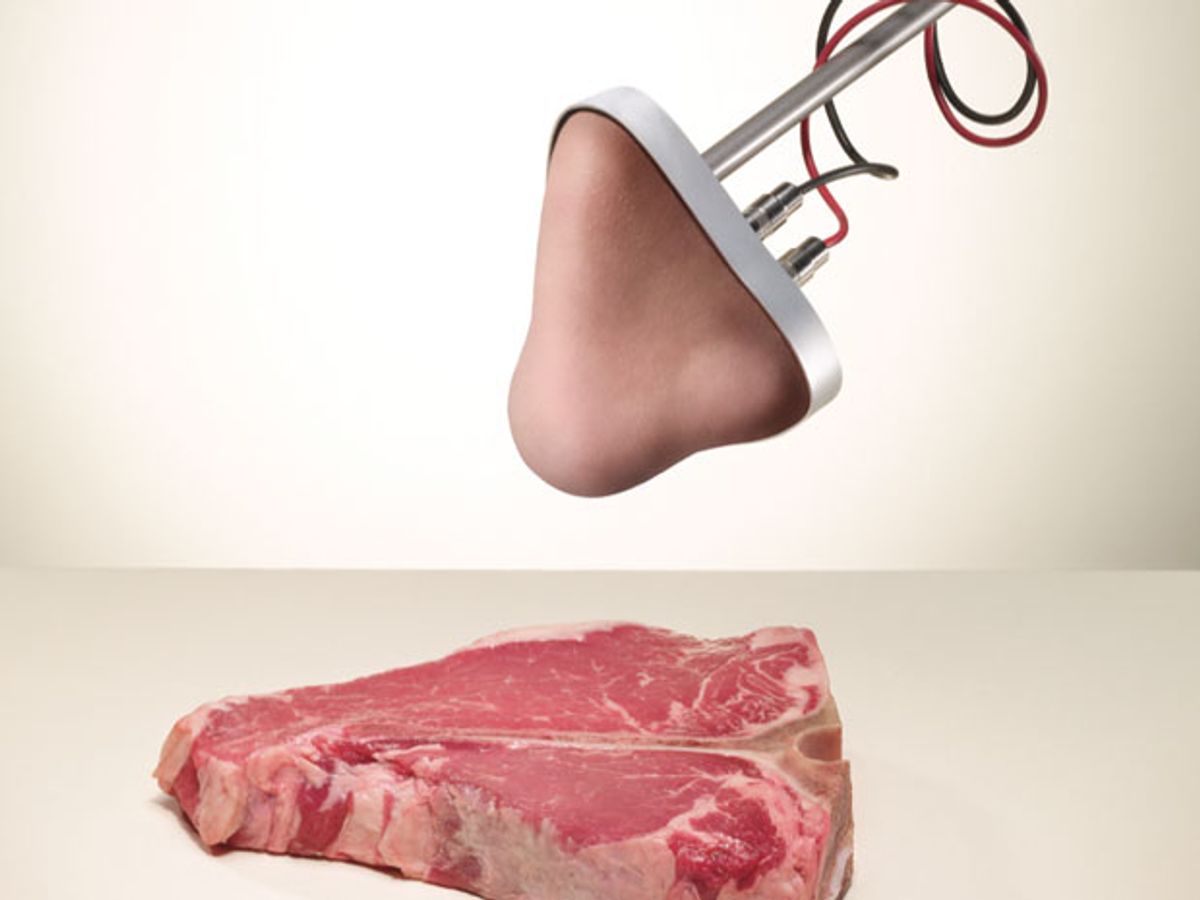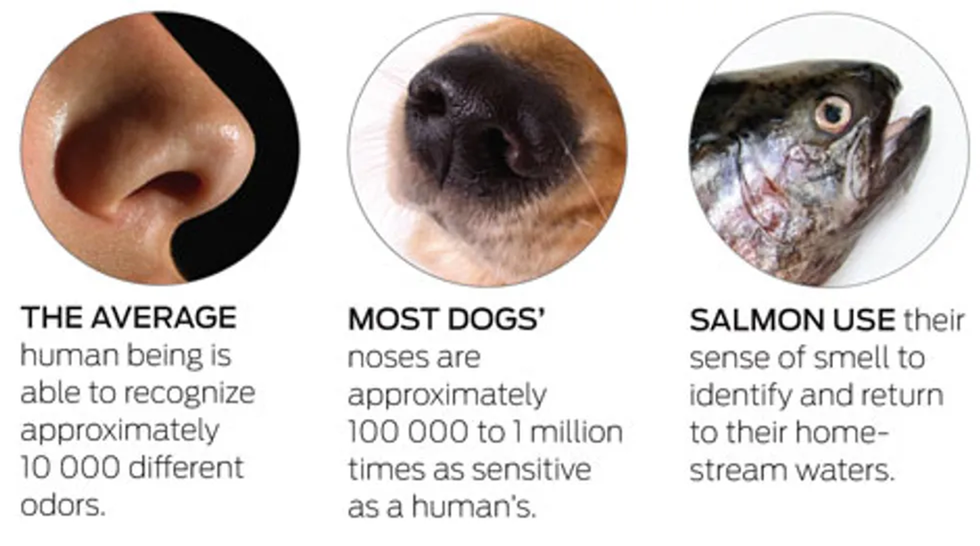Electronic Noses Sniff Success
E-noses will soon be ubiquitous, thanks to printed organic semiconductors

Several hundred years ago, village doctors in rural China diagnosed diabetes by the characteristically sweet smell of a patient's breath. Today hospitals use a battery of blood tests and laboratory analyses to make that same diagnosis, but doctors may soon be sniffing their patients' breath again. This time the doctors will have electronic noses small and cheap enough to carry in their pockets.
This e-nose will be the culmination of decades of work at countless laboratories, where researchers have sought to create a tiny, cheap, automatic sniffer that would let wine bottles monitor the aging of their contents, allow meat packages to flag spoilage, and enable mailboxes to check for bombs. Imagine barroom coasters that double as Breathalyzers, bumper stickers that monitor car emissions. Until now, it's been just so much sci-fi.
E-nose technology has quietly advanced during the past two decades. Commercial models equipped with sensor arrays came to market in the mid-1990s, and today they're used to distinguish wines, analyze food flavors, and sort lumber. Benchtop systems are also used in the pharmaceutical, food, cosmetics, and packaging industries, while smaller, portable units are used to monitor air quality.
But these noses cost in the range of US $5000 to $100 000. A coming convergence between e-nose technology and advances in printed electronics will finally bring the price down—way down. Within a decade we'll see e-noses that cost tens of dollars and appear in smart packaging for high-end items like pharmaceuticals or as part of intelligent or interactive appliances—picture a refrigerator that knows when milk has gone bad. Prices could easily drop to under a dollar by 2020.
The secret? Conducting polymers. Developers of both electronic noses and printed electronics are exploiting these materials, which can be sensitive to the chemicals that make up odors and are also capable of producing electrical signals. E-nose developers are concentrating on honing the sensing properties of conducting polymers, while the printed-electronics people are investigating ways of using these materials to fabricate ultralow-cost electronics. Combining the fruits of these two separate efforts will finally bring e-noses into our supermarkets, homes, and daily life.
The human nose is an astounding organ, with millions of odor sensors of hundreds of different types. They let an average adult detect 10 000 different odors, which are usually a complex mixture of vapors, or what chemists call volatile organic compounds. Some arise from chemical concentrations in air down in the parts-per-trillion range. A normally functioning person can tell the difference between fresh milk and milk that's gone bad or walk into a house and notice that it's a pie that's baking, not a turkey, merely by sniffing.
Volatile organic compounds shape the aroma and taste of most foods and can act as keen indicators of freshness and quality. But a fresh-cut orange, say, or a piece of Swiss cheese may release hundreds of these chemicals. As far back as the 1950s, researchers built sensors that could detect and quantify the sprawling assortment of chemical components of an odor. But these sensors were difficult to design and had limited use. Even today, most of these basic chemical sensors operate on a lock-and-key strategy, in which a targeted sensing mechanism picks out one specific kind of molecule from the dozens or more in an odor.

In 1982, Krishna Persaud and George Dodd at the University of Warwick, in Coventry, England, put together the first sensor array for odor recognition—that is, a collection of electronic sensors, each of which responded in different ways to a range of volatile chemicals. Persaud and Dodd used oscillating semiconducting transducers that changed frequency when they detected certain compounds.
In 1988, Julian Gardner, also at the University of Warwick, dubbed this approach the electronic nose. Rather than cataloging the chemical compounds of an odor, an e-nose identifies complex odors by using pattern-recognition strategies similar to those of the human olfactory system, albeit with different sensing mechanisms. Given a glass of wine, the average person knows from the smell alone what the liquid is. But only a serious oenophile might be able to break the odor down into its constituent parts: alcohols, acids, and esters. The human nose has hundreds of different types of odor sensors, whose response patterns are processed by the brain, which then searches its memory for matches to stored response patterns. An electronic nose uses far fewer sensors; commercial systems have around 10 to 50 sensing elements.
Your typical e-nose consists of a sampling system, a gas-sensor array, and a signal processor coupled to a pattern-recognition system of some sort. The sampling system brings vapor-laden air into the sensor array; in a laboratory setup it might have a fan that blows air across the array in an action reminiscent of human sniffing. The nose might allow a vial of air to be released inside it; perfume makers capture samples this way. Or it might work passively, simply because the array is exposed, like the sensor in a smoke detector.
In the sensor array, each of the sensors responds to a broad range of gases, with much duplication; multiple sensors will respond to the same gas, but not in the same way, and not to all the same gases. To identify specific odors requires the signal processor to analyze the array response with pattern-recognition algorithms; in today's expensive electronic noses, a microprocessor uses a large set of stored algorithms to sort through patterns. In the future, however, single-purpose noses looking for a simple change—food gone bad, for example—could use application-specific integrated circuits for analysis.
Much like that of the human nose, this type of odor recognition is more flexible and more powerful than what is possible with a lock-and-key sensor, which can detect only a single compound, say, carbon monoxide. Such a sensor would have a hard time telling the difference between Grandma's apple pie and Mom's. But it may be possible to train an array-type e-nose to discriminate between them and all other apple pies.
And unlike systems based on lock-and-key sensors, electronic noses can be enormously flexible. Rather than developing one nose for wine monitoring and a different one to detect bad fish, the same piece of hardware could be trained separately for different tasks. Imagine an electronic-nose system shipped with standard pattern-recognition libraries. Load up one for the refrigerator and the system will sniff for spoiling foodstuffs; load up a different one for the garden and the system searches instead for the telltale odors of snails and other pests. And what if you want the e-nose to learn the difference between Grandma's apple pie and Mom's? Well, chances are the manufacturers will have never met Grandma or Mom or sampled the output of their ovens. But they may have included software for generating new pattern-recognition libraries. If so, you would hook up the nose to the training system, introduce it to one apple pie at a time, and find out if the pies generate distinguishable responses in the array. If they do, then generate a new library, load it up, and you've got a personalized apple- pie connoisseur.
In training a nose, it is not necessary to fully understand the chemical differences between good wine and bad wine or between two pies; it is enough that the nose knows. So to teach a nose, a developer simply presents, say, 10 samples of wine gone bad and 10 samples of good wine and asks the system to find a pattern that represents the difference and to use that to distinguish good from bad in the future.

In 1998, the University of Warwick's Gardner along with Philip Bartlett, of the University of Southampton, predicted that “the next decade should see the cost of electronic noses fall dramatically” and that they would “be used not only in industry but also in everyday life.” It didn't happen. Today commercial prices for electronic noses are the same as they were in 1998, typically about $10 000. Even simple consumer products like handheld Breathalyzers and carbon monoxide monitors, which usually target only a single compound and are therefore much simpler, sell for $50 and up.
Electronic noses have been expensive up to now because they use different technologies—electronic circuitry for signal processing and pattern recognition along with multiple chemical sensors that have to be separately wired together—and so can't easily be mass-produced. In many cases, a personal computer runs the signal-processing software; the sensing apparatus is simply plugged into it. These patched-together systems have limited uses and aren't suited for high-volume, low-cost consumer markets.
Researchers have tried to integrate the sensors into the circuitry—that is, to make them on a single chip with traditional semiconductor-manufacturing techniques typically using the CMOS process. This is theoretically possible, as sensors are normally made out of metal oxides like tin, copper, nickel, or cobalt oxide; these can be deposited on a wafer. However, a typical CMOS chip has 20 to 40 layers; add in 50 sensors, each with a slightly different composition requiring separate deposition steps, and you've doubled the complexity. In addition to the cost of these extra steps, each layer also introduces defects that hurt yield and therefore raise the cost of each device. And you couldn't manufacture these chips in a multipurpose factory: introducing exotic materials into that environment could hurt yields of traditional chips made on the same line, so you'd have to build your own very expensive manufacturing line. The hurdles for a CMOS e-nose, therefore, are not readily surmountable and have stalled the progress of low-cost electronic noses for years.
Advances over the past few decades in the capabilities of conducting polymers, however, have given e-nose researchers new hope. These materials can be deposited from a solution, enabling them to be cheaply and easily painted or printed onto substrates.
These are organic polymers, which are long molecules with carbon backbones. Carbon, with its four valence electrons, has an enormous capacity for chemical interactions with other materials. This capacity makes organic polymers ideal for sensing applications because they can be designed to interact in many different ways with many different vapor molecules. Most organic polymers are electrically insulating, but by tweaking the structure, designers can produce some electrically conductive polymers by making it easy for charge to travel along the carbon backbone of the molecule.
For a gas sensor to actually “sense” an odor, it must translate a response—which is often a subtle chemical interaction between the sensor and the odor—into an output that can be easily interpreted, such as a color change. Conducting polymers excel at this translation because the chemical interaction between an organic polymer with a vapor molecule can change the polymer's electrical characteristics, resulting in an electrical response that is cheap and easy to detect.
In the early 1990s, scientists first demonstrated that a variety of conducting polymers, each with different electrical characteristics, could be integrated on a single substrate using a process called serial electrodeposition. In this process, the manufacturer repeatedly dips a substrate into a chemical solution containing the chemical building blocks of the sensing polymers. Then an electrical bias is applied, which induces the molecules to polymerize. Polymerization is the process by which many identical small chemical building blocks, called monomers, come together to form long chains.
By slipping low concentrations of different chemicals into the mix during polymerization, scientists can modify the characteristics of the final polymer. Using this method, only one type of material can be deposited at once, so manufacturers must repeat the process multiple times to get different polymers onto the same substrate.
While conducting polymers are potentially soluble, the majority of conducting polymers used for sensing today are not. The advantage of going to soluble polymers is that manufacturers already have tools for laying soluble polymers on a substrate cheaply, reliably, and quickly. They print them the same way an inkjet printer quickly deposits various colored inks to make color printouts. Printing allows the placement of many types of different materials next to one another on the same substrate. In printed sensors, then, additional sensor materials can be incorporated by adding extra print heads; additional process steps are not required. Processes like these have jump-started the emerging field of printed electronics, with the first new products, like e-books by Sony and Amazon, just now reaching consumers. Also, printing is compatible with roll-to-roll processing, in which sheets of substrate are continuously processed, as opposed to processes such as electrodeposition, in which small samples of the substrate must be dipped individually into different batches of solution. The roll-to-roll method speeds up manufacturing considerably, which brings down the cost.
Printing polymers doesn't completely solve the manufacturing problem for e-noses, however. It is very rare to find the properties of conductivity, sensitivity to vapors, and solubility in a single organic polymer material. To get around this, researchers can incorporate conductive non-sensing materials into a soluble, sensing—but nonconductive—polymer. Visualize a pudding with raisins in it. Conductive raisins are suspended in a pudding that swells in the presence of certain odors. At a sufficiently high raisin density, randomly adjacent raisins would begin to form complete paths through the pudding to allow charges to percolate through. Carefully adjust the raisin density to rest near this threshold and you can expect any expansion or contraction of the pudding to strongly affect the number of percolation paths through the pudding.
There are two different types of “raisins” that developers use to form these soluble, conductive polymer composites. One is carbon black, which is made up of conductive carbon particles small enough to suspend easily in a soluble polymer solution. The other is polypyrrole, a common soluble, conductive polymer.
Researchers are testing methods of using these polymer composites to print sensor arrays along with support circuitry on an integrated circuit chip. Electronics manufacturers have been developing techniques for printing organic electronics for a decade at least, focusing on printed displays, memories, batteries, organic thin-film transistors, and photovoltaics. Printed electronics in some of these applications are nearing their last stages of development before commercialization. Although many of the organic conductive materials used in these applications are similar to those used in e-nose research, no developer has yet reported printing organic electronics for low-cost gas-sensor arrays.
In 2006, researchers at the University of California, Berkeley, reported using an array of integrated printable organic semiconductors to differentiate between basic classes of odors, such as acids, alcohols, amines, and thiols; for example, this sensor array was able to distinguish wine from vinegar. In October 2007, researchers at MIT announced that they had successfully printed barium carbonate, which can detect a range of gases, onto a silicon chip. This is yet another printable sensing material that could enable printed gas-sensor arrays, though it has yet to become part of a working e-nose system.
The main hurdles to wide commercial use of these organic polymers involve their instability and short lifetimes. For odor sensing, a stronger chemical interaction between the sensor and the vapor improves the sensitivity of the sensor. However, the stronger the interaction, the more likely that the interaction will not be completely reversible. Put another way, the complete reversibility of the sensing interaction prolongs sensor lifetime, because the sensor is not permanently changed by the odors.
The most stable organic materials are the ones that do not interact with the environment at all. But no interaction means no sensing, of course. So gas sensors based on organic electronics must balance chemical sensitivity with resistance to degradation. Fortunately, there are a multitude of ways to tweak the properties of organic electronic materials to find the balance. Because the carbon atoms in the backbone of these substances bond easily with other materials, researchers can tack on or take off atoms of oxygen, nitrogen, or sulfur, for example, and change the shape, electrical response, or other properties of the polymer.
Making such changes has let researchers build electronic circuits that are sensitive to various gases. “Chemiresistors” change resistance in response to certain vapors, “chemicapacitors” change capacitance, and “chemitransitors” exhibit a variety of electrical changes in response to a particular vapor. As designers can also create standard resistors, capacitors, and transistors using organic electronics, they could incorporate sensing and signal processing into a complete e-nose package that could be manufactured cheaply.
It will take perhaps a decade more to increase the performance, yield, and reliability of organic electronics in order to make a cheap electronic nose a reality. Sensitivity, selectivity, and reproducibility of printable sensors all need improvement. Applications with lower cost margins, such as monitoring perishable items at the grocery store, will require aggressive refinement of ultralow-cost printing techniques. More critical applications, like disease diagnosis, would require stringent improvements in accuracy and reliability as well as rigorous field testing. But once the technology is ready, printed electronics could do for e-noses what the printing press did for books: it could allow them to go from rare to ubiquitous in the blink of an eye…or the sniff of a nose.
To Probe Further
To learn more about printed electronics, visit https://www.printedelectronicsworld.com.
For more information about electronic noses, see Electronic Noses: Principles and Applications , by J.W. Gardner and P.N. Bartlett, Oxford University Press, 1999.
For a description of the printable organic semiconductor sensor array demonstrated at the University of California, Berkeley, see “Printable Polythiophene Gas Sensor Array for Low-cost Electronic Noses,” Josephine B. Chang, Vincent Liu, Vivek Subramanian, Kevin Sivula, Christine Luscombe, Amanda Murphy, Jinsong Liu, and Jean M. J. Fréchet, Journal of Applied Physics 100, 014506 (2006).